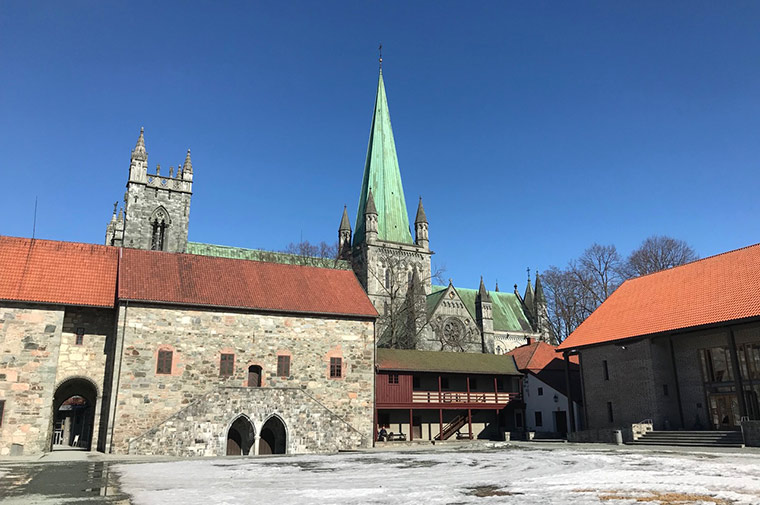
His statue stands tall above Trondheim's market square. But how much do you know about one of Norway's former Viking kings?
He lived more than 1,000 years ago, yet Olav Tryggvason is one of Norway's most famous names. That's especially true if you're living in or visiting Trondheim, where you can't miss the statue of Olav on the city's market square.
Visitors often assume the statue is Saint Olav, but that's actually a different person! There were two kings called Olav, or Olaf, as the name is often written in English. The first, Olav Tryggvason, was the founder of Trondheim. The second, Olav Haraldsson, went on to become Saint Olav.
Read more: Fun Facts About Trondheim, Norway
Yet while being one of Trondheim's most famous sons, Tryggvason actually lived much of his life outside of Norway. Read on to discover the history–as we know it–of this fascinating character.
The early years of Olav Tryggvason
Despite being one of Norway's most famous kings, Tryggvason only took the throne for five years. In addition, very little is known about his life before he came to Trondheim.

It is believed that Olav Tryggvason was the son of Tryggve Olavsson from Viken. Later sagas claim that Tryggve Olavsson was an offspring of Harald Fairhair (Harald hårfagre), who was said to be the first king of Norway, serving from 872 to 930.
Read more: A Brief History of Norway
The oldest saga on which we base some of our knowledge about the King tells a fairytale-like story about how he had to flee the country as a child. The pursuer was the “evil Gunnhild”, in what history professor Claus Krag told NRK was “a clear parallels to Jesus' life.”
Tryggvason in England
Although there are doubts about Tryggvason's earliest years, Krag said we know that he was with the Danish king of England during the conquests of the 990s. “He changed sides and formed an alliance with the English king Æthelred 2,” he explained. The English king was also known as Æthelred the Unready.
In 994, Tryggvason was confirmed as Christian in a ceremony at Andover, where Æthelred stood as his sponsor. That being said, it's believed he had converted to the religion many years previously.

The earliest known written record of the Norwegian in English came in the Anglo-Saxon Chronicle, a document that has revealed many aspects of Viking history. Olav promised “that he would never come back to England in hostility.”
With this new alliance against the Danish king Earl Håkon Sigurdsson, who had power in Norway at the time, Tryggvason headed to Norway. He did not return.
Tryggvason in Norway
Olav brought an army of men and rich goods to Trøndelag, which was in the middle of a rebellion against Earl Håkon. According to contemporary English sources, Tryggvason left England with ten tons of silver and gold aboard five longships. After the Danish king was murdered during the rebellion, Tryggvason became king.
Rock carvings show that people had been living in the region for thousands of years. The fjord and river provided easy trade routes and a natural barrier against attackers respectively. Here he founded the city now known as Trondheim in the year 997, and quickly set to work.

Olav chose the name Kaupangen which was quickly changed to Nidaros. The city of Nidaros remained Norway's capital until the 13th-century. Some time in the late Middle Ages, the city became known as Trondheim.
His other principal act as the first Christian king was to allow the introduction of Christianity into Norway. The religion had already gained a foothold in the country, but the king's decision hastened its adoption.
That being said, only small progress was made in central Norway in the early days. In hindsight, Olav is credited with preparing the ground for what Olav Haraldsson (Saint Olav) would go on to do later.
Olav remained on good terms with England and introduced coins and a system of rule both modelled at least in part on the system used in England and elsewhere in Europe.
His death and legacy
However, the reign of Olav Tryggvason was a short one. Barely five years after assuming power, he suffered what was described as a “heroic death” in the year 1000. He died in the Battle of Svolder in the western Baltic Sea.
However, the exact circumstances of his death are shrouded in mystery, as is the precise location. “He has become a truly mythical figure,” said Krag. One popular account of the battle's conclusion reads: “His ships were captured one by one, last of all the Ormen Lange, which Jarl Eirik captured as Olaf threw himself into the sea.”
Since the days of Tryggvason, Trondheim has gone on to thrive and become one of Norway's most important cities. The city has grown far to the south and east of its original location on the banks of the Nidelva river.
Today almost 200,000 people live in Trondheim and Tryggvason's statue continues to watch over them. Many people, cars and buses travel along Olav Tryggvasons gate every day on their way to work or play.


Thank you, David, for your article. I was able to see some of the results of this excavation last summer of 2019. Most interesting story! I look forward to hearing the results of how and why down the road.
Ruth Anne
Did King Olav bring Christianity to Norway when he returned? My distant relative was the chief archeologist for Nidaros Cathedral and when we were children he told me some stories about Olav, who returned to Norway and spread Christianity (with a sword) throughout western Norway.